Editor's Note
This story was made possible with the help of KCETLink, a national independent public media organization and our partners in the documentary series The Migrant Kitchen.
South Korea is roughly the size of Indiana (with 7.5 times its total population), and the 27th most populated country as of the 2016 census (one of the top 10 most populated cities is its capital, Seoul, hovering around 10 million and counting). It is divided into nine provinces and seven metropolitan cities, creating diverse dialects and regional cuisine. For a country that has only recently experienced a culinary boom stateside, there is a deep, rich history beyond the bevy of infamous green soju bottles and all-you-can-eat barbecue (which is a Westernized concept, by the way, since quality meat was, and still is, a premium item). And while Koreatown is one of the most densely packed districts within Los Angeles County, with more retail signage written in Korean Hangul and waves of Korean brands opening U.S. locations every day, the vastness of Korean cuisine is still unbeknownst to many locally.
Similar to Seoul itself, there are countless hidden gems and small businesses in every corner, and many families have planted roots and stayed in operation since the ‘80s and ‘90s. Through the turbulent Los Angeles riots and the rebuilding of communities, Korean immigrants have persevered and made an impact in shaping Los Angeles culture between Vermont and Crenshaw, from Beverly down to Olympic. Los Angeles has been a home away from home for many Koreans, and stylistic interpretations such as “L.A. Galbi” (a specific cut of short ribs) are now popular in Seoul as well.

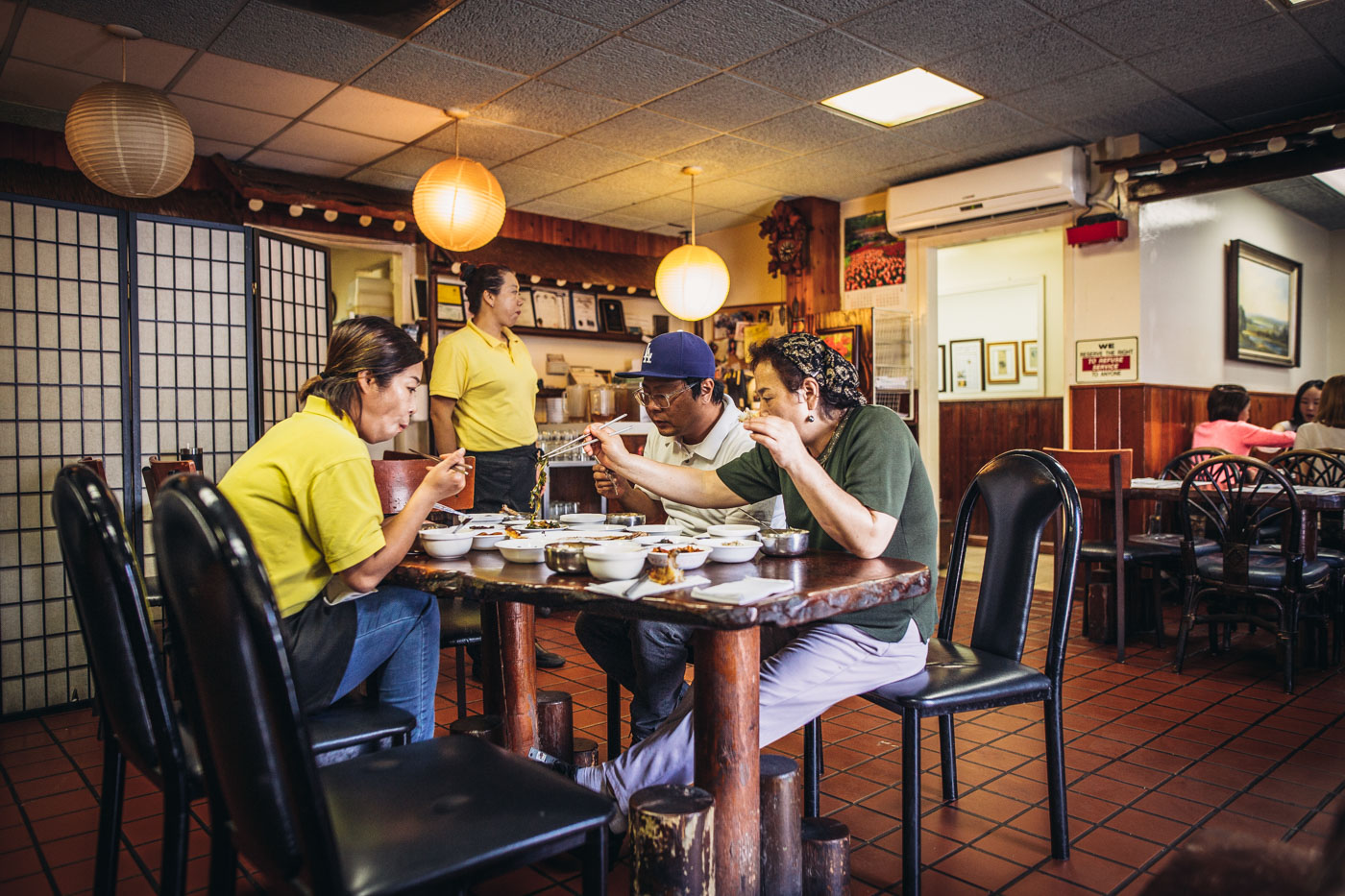
Beyond the flashy 24-hour cafés and KBBQ restaurants lies an underbelly of true regional cuisine, ranging from traditional North Korean influences behind cold nengmyun noodles and handmade mandoo dumplings, to oceanic reverence in eondaegu jorim (braised black cod), bajirak kalgooksu (little neck clams with hand-cut noodles), and jeonbokjook (fresh abalone congee). And there are plenty of soups and stews for all seasons—think samgyetang (Cornish hen stuffed with glutinous rice, ginseng, chestnut, dates, garlic), yukgyejang (spicy shredded brisket with bean sprouts, scallions, onions), and cheonggukjang (fermented soy bean stew)—which are traditionally consumed during hot summers.
And let us not forget janchi, the traditional feast cuisine when grandmothers, mothers, aunts and sisters can really show off their skills. The likes of beautiful jeon (thin, savory pancakes made of seafood, mountainous greens or potato), a colorful array of banchan (small side dishes accompanied in every meal), and dduk (beloved rice cakes, often earthy and lightly sweet) decorate a family-style table setting.
Regionality and cultural tradition play large factors in what Koreans eat, how the food is prepared, and when it is consumed. But one thing is clear: Korean cuisine is, by definition, true family-style. It’s not heaps of food like a medieval buffet; rather, a communal gathering and sharing of entrees and sides, serving elders first, and refilling small plates and empty glasses with a sense of innate hospitality. It is a universal commonality that all ethnic cultures express history, tradition and celebration through food, and I dare say that every L.A. resident who has driven through K-Town has experienced it in one shape or form. That hospitality is represented by many traditions, but perhaps most evidently through the customary banchan service.
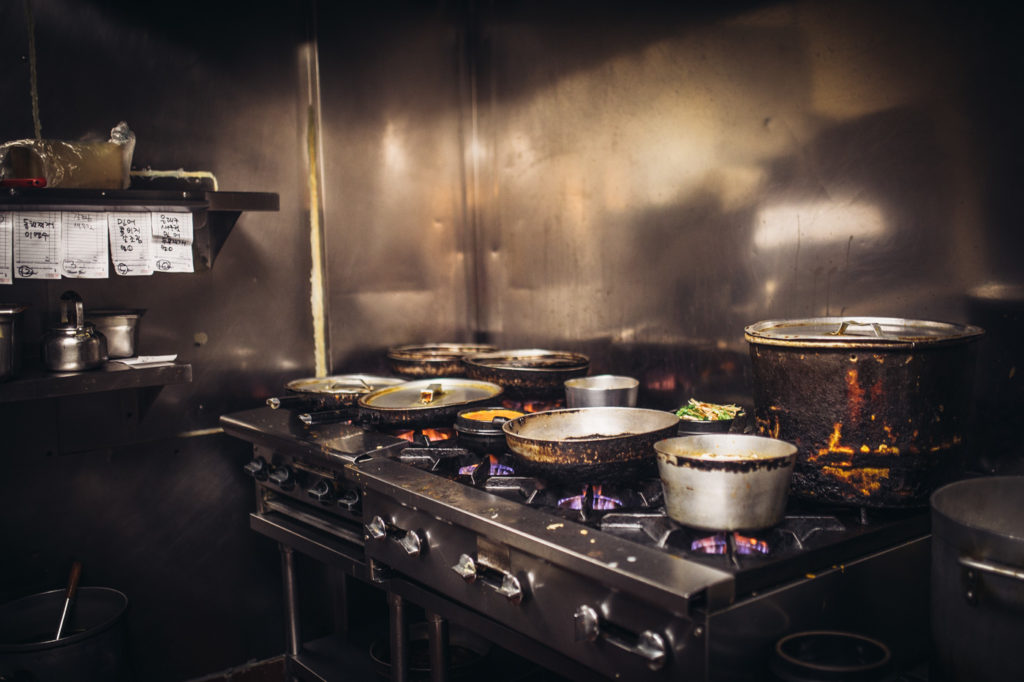
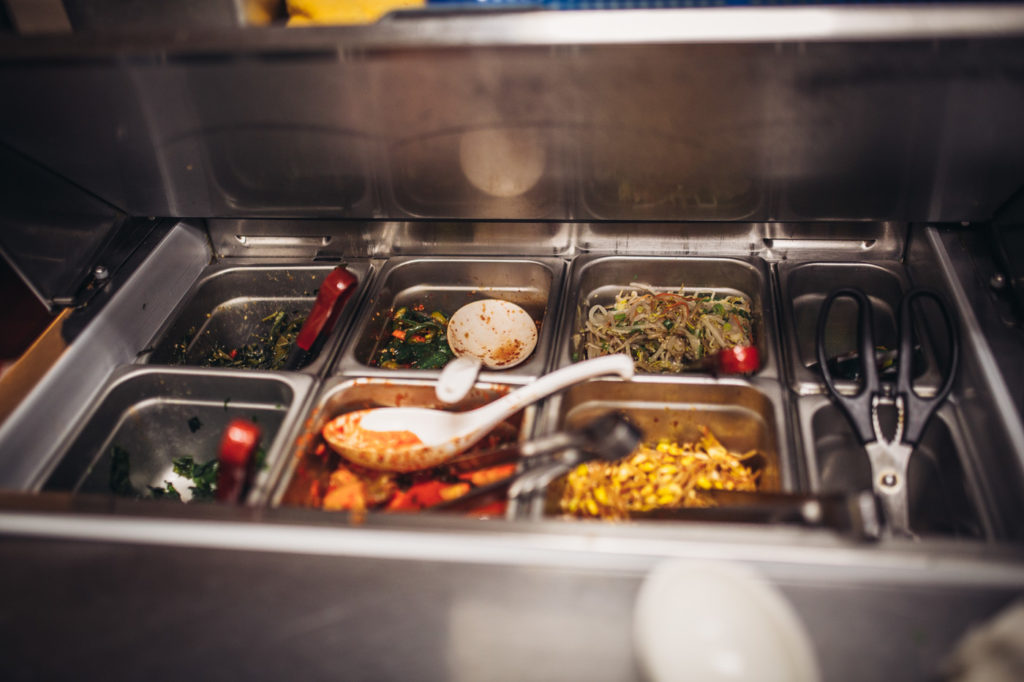
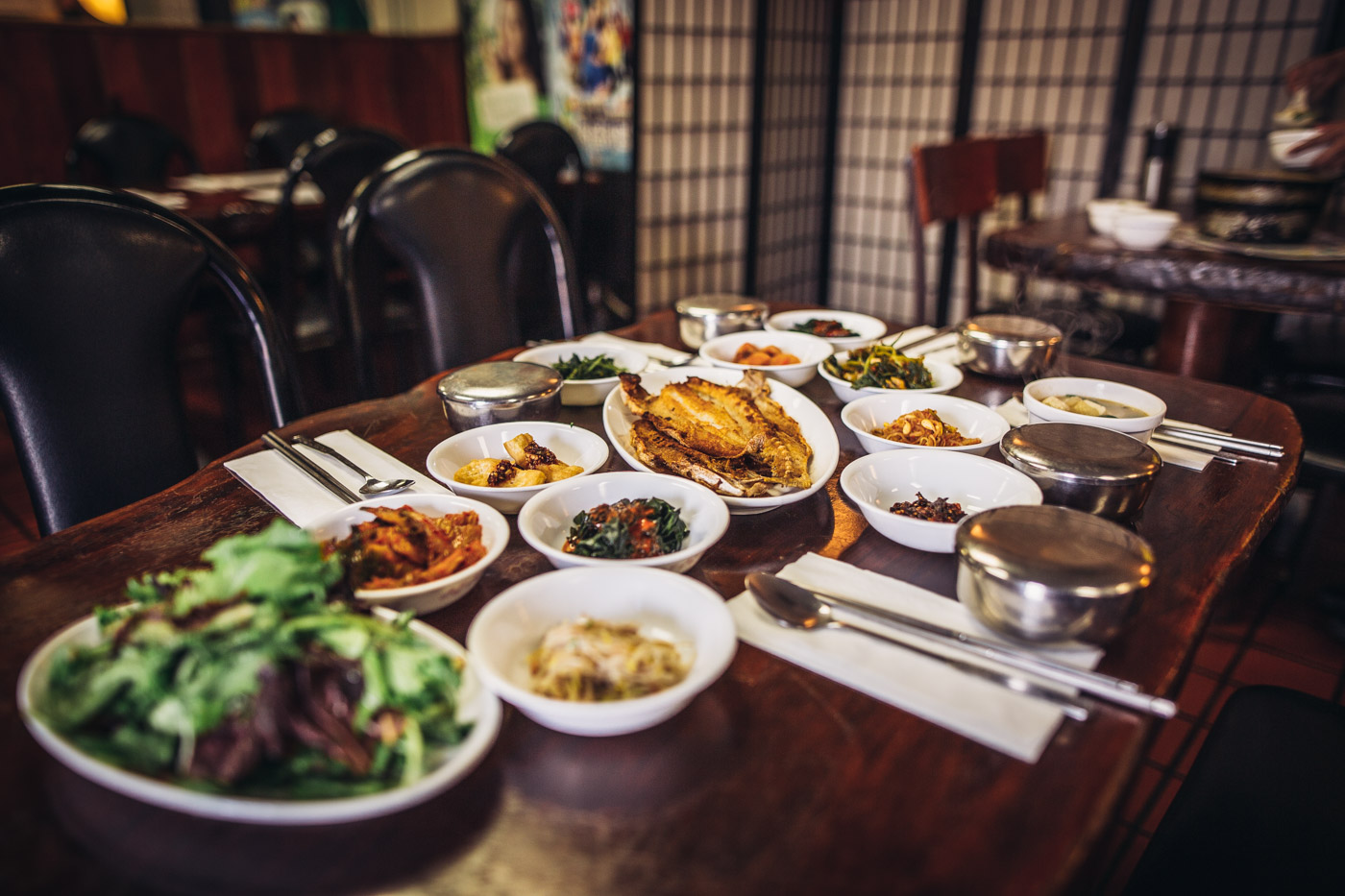
Banchan is an important part of Korean cuisine, from the most humble, simple dinner made at home to a full spread seen at janchi ceremonial celebrations and royal court cuisine. It is absolutely indispensable and always—always—accompanies any and every meal. Even pubs and street food stalls will offer at least one or two small banchans because it is a definitive part of Korean cuisine. The larger the variety, the more it showcases a quality of care, service and economic stability.
Since Korea is located between mountainous terrains and a peninsula surrounded by three seas, it has a highly seasonal cuisine with a heavy focus on seafood, grains and vegetables (meat became more popular and accessible post-Mongol invasion and later with 19th century world trade). Historically, the strictly vegetarian Buddhist diet dictated much of the Goryeo dynasty (10th to 14th centuries), and practices of fermentation and pickling were seen as early as the prehistoric Three Kingdoms era. To this day, four full seasons are enjoyed in Korea, and it is natural for people to cook and eat based on the time of year (New Year, Lunar New Year and Chuseok Thanksgiving during autumn harvest are most significant).
The best way to understand banchan is by general categories of ingredients and preparation. An infinite variety of banchan can be grouped into the following culinary techniques: kimchi and jangajji (fermentation and pickling), namul muchim (lightly seasoned ingredients, in particular, vegetables, roots, sprouts), bokkeum (lightly sautéed or stir fried), jorim (braised in seasoned broth or sauce), and jjim (steamed). There is also a variety of jun (thinly pan-fried savory pancakes and small meat patties) that are associated with larger feasts rather than an everyday casual meal. Three in particular will always appear, no matter how great or humble the table setting: kimchi, namul muchim and jorim.

Kimchi
Kimchi is the traditional side dish most commonly associated with Korean cuisine. It is the national dish of Korea, with a strongly significant cultural preparation (called gimjang, which is traditionally done in November and December). Today, we see kimchi refrigerators that perfectly control pressure and temperature for the modern-day household, no longer storing kimchi in outdoor hangari or underground stone jars for natural fermentation through all four seasons. Over 150 varieties have been quoted, ranging by seasonal vegetables, seasoning and region.
The common breakdown can be categorized as follows: cabbage (baechu, baek kimchi), radish (kkakduggi, dongchimi, chonggak), cucumber (oi sobagi), and greens (radish and mustard greens, green onion, chives). There are also varying levels of spice and seasoning—some are white with a subtle, sweet brine, while others are heavily seasoned with a lot of heat and seafood extract (which are most often shrimp, anchovy or oyster based). Most will include salt, garlic, gochugaru (ground chili pepper), ginger, scallions and spices in the initial brine.
In line with seasonality, kimchi is also prepared and consumed within each quarter—spring and summer naturally bring lighter variety as well as a shorter brine, while autumn and winter mark the heavy preservation season to ferment and carry stock through the long stretch and into the new year. Gimjang is a tradition in which relatives and neighbors gather to prepare large quantities of kimchi from start to finish; it is a highly laborious task, most often undertaken by the women of the house. Certain homes (and restaurants) are highly revered for their particular kimchi, and neighbors earn bragging rights when their particular batch is especially delicious that winter.
Kimchi is also revered for its metabolic and digestive benefits. Seasonal ingredients provide a wide range of vitamins, while its natural fermentation produces highly sought-after probiotics. It is common to find kimchi among health and nutrition sources for foods with naturally occurring lactobacillus. The best part of kimchi is its versatility—when table banchan over-ripens into a sour flavor, it can then be cooked into kimchi fried rice (bokkeum bap), stew (jjigae), and savory pancake (jeon), to name a few. Similar to using ripened bananas for banana bread, the rich kimchi brings new flavor when cooked and stewed.

Namul Muchim
Namul muchim covers a large variety of banchan due to the abundance of vegetation in Korea. Namul means vegetable or root; muchim means to season. It is a broad term for any and every dish prepared in this manner. Most vegetables and mountainous herbs are sautéed, seasoned, marinated, steamed, dried or even enjoyed semi-raw. This is where spreads will vary in seasonality and preference between homes and restaurants, from popular common dishes to highly skilled preparations. Most involve cooking oil (sesame), vinegar, soy and alliums, and common ingredients such as sprouts, shoots, root vegetables, hearty herbs, oceanic greens and radishes. Whether stir fried, pickled or lightly sweetened, using the entire ingredient is also important—the roots, stems, leaves, seeds, flowers and fruit. Most table settings will include a healthy variety in color and technique for a well-rounded meal.

Jorim
Jorim is as common as bokkeum and jjim, but is particularly associated with specialized Korean dishes that require low and slow simmering in a seasoned sauce or marinade. This technique is applied to banchan (mostly vegetables, kimchi or tofu stew), as well as main entrees (most meat and seafood), often using a soy base. The seafood ingredients require stronger chili spices and aromatics to complement the flavor. Popular year-round jorim dishes include lotus root, burdock root, tofu, braised and shredded brisket, black cod and mackerel.
Lucky for Angelenos, Koreatown feels a bit like instantaneous travel to South Korea, thanks to the ethnic community bustling 24 hours a day, overflowing with hundreds of eateries, banchan-specific retail stores, and Korean markets that include freshly-made entrees and sides. In fact, several restaurants were featured specifically for their banchan quality in the Los Angeles Times in 2015, indicating the growing popularity and familiarity of Korean cuisine locally.
——
Discover Los Angeles’ Koreatown in The Migrant Kitchen
In Koreatown, the family behind Jun Won Restaurant faces the challenge of preserving the business they’ve built over two decades when they’re forced to close.
Watch The Migrant Kitchen: Banchan
——
Illustrations by Cesar Diaz





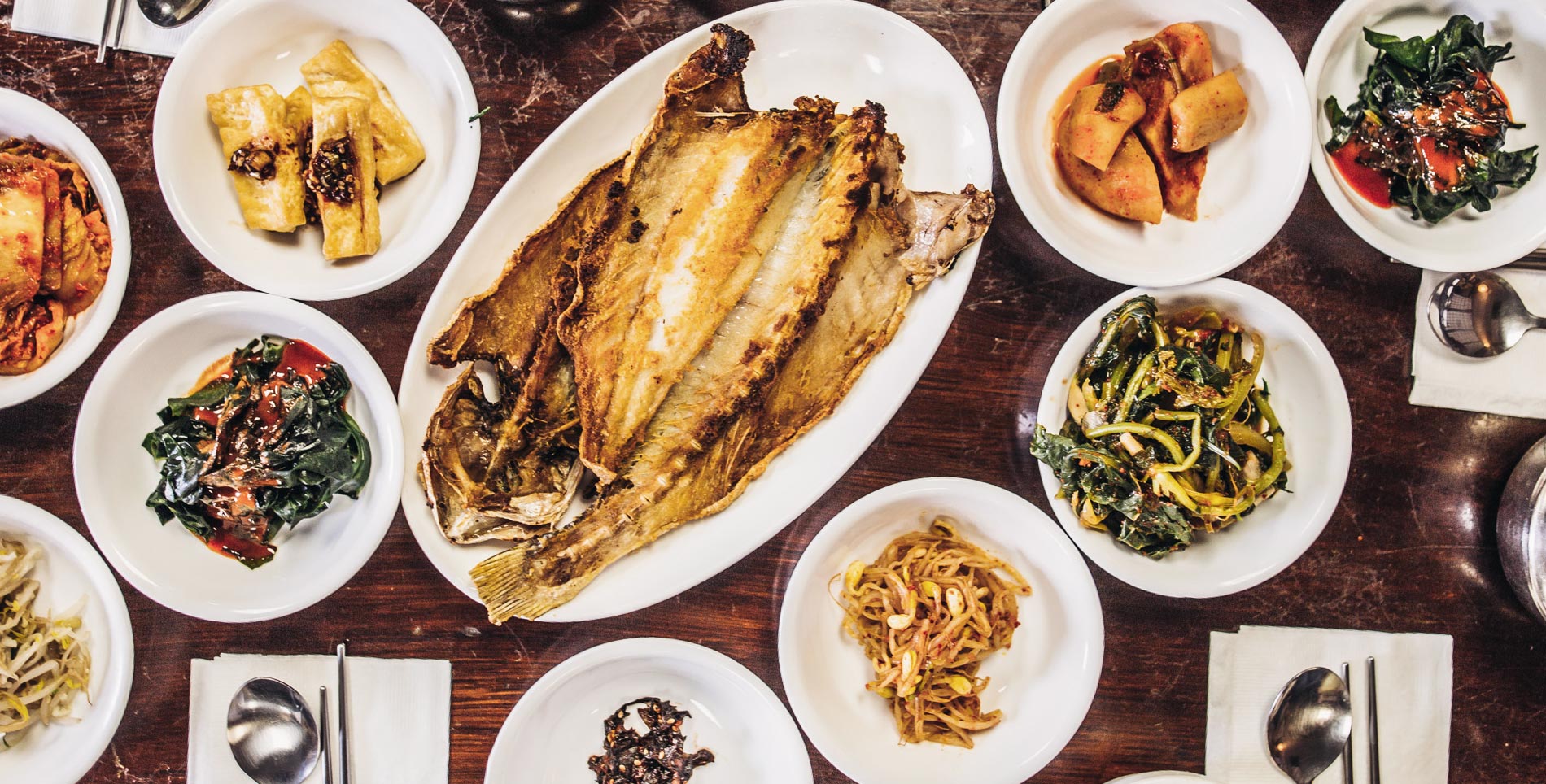

Our comments section is for members only.
Join today to gain exclusive access.